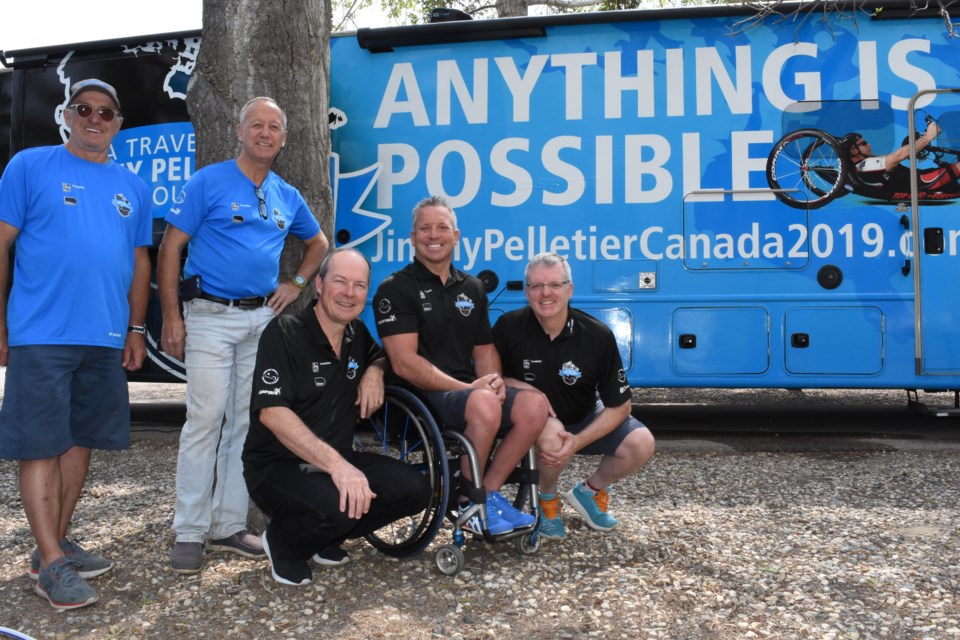When Paralympian Jimmy Pelletier rolled through Saskatchewan during his Canadian cycling tour, he had completed 25 per cent of his trip but was already at 60 per cent of his fundraising goal.
La Traversée Jimmy Pelletier, or, Jimmy Pelletier: The Journey, started in Vancouver in early May and will end by mid-July in Halifax. Pelletier and six other cyclists — plus a team of drivers, a cook, physiotherapist, and massage therapist — will travel 7,200 kilometres in 67 days, as they attempt to raise $500,000 for people suffering from autism spectrum disorders and physical or intellectual disabilities.
Pelletier has invited all Canadians to keep him rolling by sponsoring one or more kilometres for $25 each. To follow the journey, visit www.latraverseeducanada.com/en/.
The trip’s slogan is “Anything is Possible/Tout est Possible.”
“We had hoped that by the end of Saskatchewan, we would have 2,000 (kilometres) sold, but we are up to 4,000 (kilometres) sold. So we are very proud of that,” explained Clemente Lemieux, Pelletier’s translator, a fellow cyclist, and the CEO for the Quebec non-profit organization Patro Roc-Amadour.
Pelletier, 42, began volunteering eight years ago with Patro Roc-Amadour, a group that supports handicapped children. In 2014, Pelletier began an annual charity event called La Randonnée Jimmy Pelletier, where he cycles across Quebec using a hand bike to raise funds for Patro.
The 2006 Paralympian athlete decided to cycle across Canada this year to celebrate the fifth anniversary of that event.
 Jimmy Pelletier and his team take a rest while riding through the mountains of British Columbia. Photo courtesy Jimmy Pelletier
Jimmy Pelletier and his team take a rest while riding through the mountains of British Columbia. Photo courtesy Jimmy Pelletier“I feel very well. In good shape. I feel good physically and mentally,” Pelletier said through Lemieux. “We’re all together, so that makes it easier.”
On average Pelletier and his team will cycle 170 kilometres per day. Their longest stretch was 186 kilometres from Fort Qu’Appelle to Russell, Man.
It’s difficult on Pelletier’s body when they have to cycle more than 150 kilometres per day, said Lemieux. He can’t raise his arms at the end of the day, which is why the physiotherapist has to work on his shoulders, arm and back.
“Jimmy is an amazing person,” continued Lemieux. He is an inspiration to many who are physically challenged. He is resilient, determined and willing to persevere. While everyone faces difficulties, everyone should keep working and believing in themselves.
Pelletier’s hand bike has no suspension, so it takes a toll on his body. It’s also difficult for him to avoid potholes while riding on the shoulder of the highway. Hitting these rough patches, rocks and gravel stretches the day to 12 hours from six, since instead of riding between 25 to 28 kilometres per hour, the team slows down to 12 to 15 km/h.
His head is 16 inches above the ground since he sits so low in his hand bike. That means Pelletier is blasted with fumes and noise from passing vehicles. With a laugh, Lemieux stated that Pelletier’s face “is not as beautiful” at the end of the day.
Throughout the trip, they have given money to charities and also stopped to speak about the journey. Pelletier met with former Humboldt Bronco Ryan Straschnitzki in Calgary, while he visited with students at École Ducharme while in Moose Jaw.
On the day Pelletier was in Moose Jaw, it was the one-year anniversary of when he reached the summit of Mount Kilimanjaro — which is 5,900 metres in height — in five days using an adaptive mountain bike.
“It was a great experience,” Pelletier said. “The challenge was to adapt myself to the altitude because I never knew how my body (would) react … . We have to live every day because you never know what is going to happen.”




